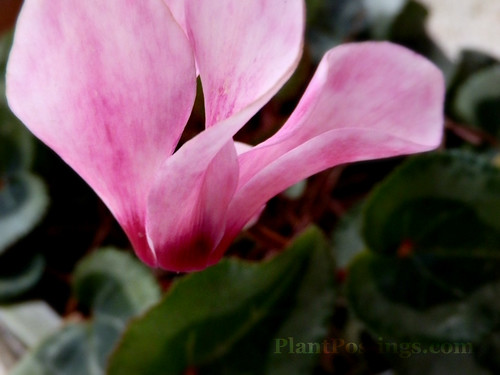
I write this post not with any pretense about success in growing indoor potted plants. On the contrary, my record with them, in general, is not good.
I can remember my dear grandmother's home filled with African violets that spanned the color range, and she was able to keep them growing for years on end, with repeat full and lush blooms. She may have had a Cyclamen or a few other blooming plants among her collection--I don't recall.
My experience is not as impressive. Historically, I've killed more indoor potted plants than I'd care to share here. But that doesn't stop me from trying. And in recent years, I've had more success (or perhaps luck). One of the plants that has surprised me with its longevity and lush growth is a Cyclamen plant I picked up four years ago.
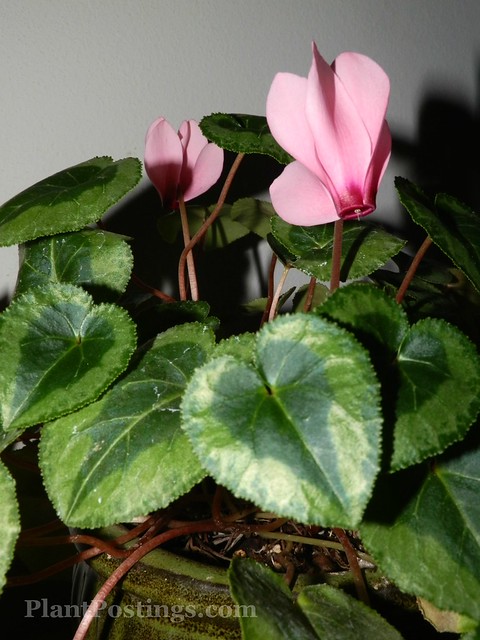
Most potted Cyclamens are florist cultivars of C. persicum, a species native to the Middle East, Northern Africa, and Eastern Europe. The species has a limited range of allowable conditions in the wild, which probably accounts for its persnickety temperament.
Now, mind you, I don't necessarily follow the rules when it comes to dealing with potted plants--particularly those that go dormant. (Visit this link to learn more about conditions preferred by potted Cyclamen plants.) I don't have the patience to put them away in a dark room, water them at a specific time, hang them upside down, and do the hokey-pokey. But for the purposes of documentation, here are the conditions and steps I've followed that have kept this little Cyclamen plant going and flourishing since 2013:
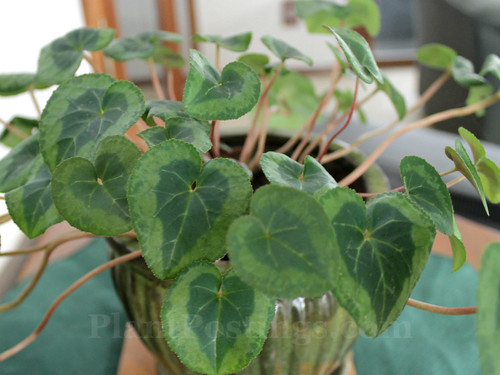
• I first transplanted my Cyclamen from its plastic retail container to the ceramic pot it inhabits to this day. I've never transplanted it again, though many recommend that practice annually after summer dormancy. This particular container has good drainage, but I used only regular potting soil with small pebbles on top for mulch/decoration.
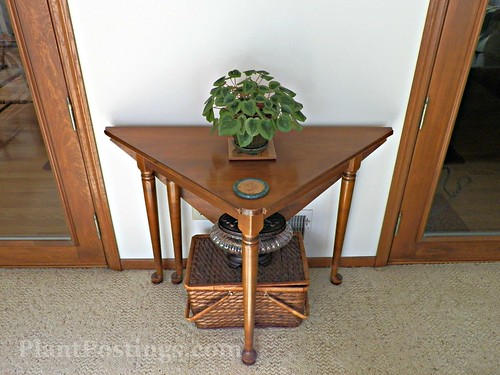
• During the winter, the plant lives on a small table on the north side of the sunroom, which faces south. Here, it receives indirect light from dawn until dusk. The room is partially heated, but is closed off from the rest of the house. Daytime temperatures range from about 50F to 70F, depending on the sunlight, the day length, and the outdoor air temperatures/wind conditions. Nighttime temps range from about 38F to 50F. The room is more humid than the rest of the house, but on dry, cold days I do mist the plants to maintain slightly higher humidity.
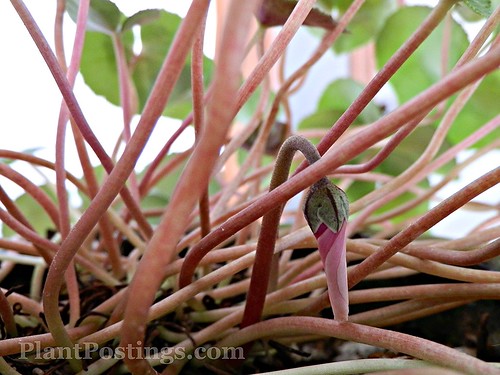
Bloom time for my little Cyclamen plant begins anywhere from early January to mid-February. I don't know why it varies--probably because I don't follow the rules. It's always exciting to see the first budding stems pop out of the soil. At first, they look very much like the foliage stems, until you begin to see the twirled pink shape of the buds.
The plant blooms, generally, through the early spring. The foliage continues to flourish until early summer.
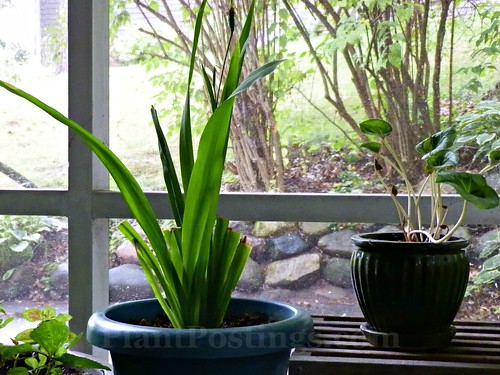
• I place the plant outside (in a shady spot protected from heavy rainfall) with most of my other potted plants as soon as nighttime temperatures consistently remain above about 40F--generally sometime in early May. If we have a very cold night with a frost predicted, I move the plants to a warm porch and cover them. Usually, by mid-May, we're beyond the threat of nighttime frost, and I do a jig.
• When the foliage begins to wither and fall off, I slowly reduce watering. It is at this point, I believe, that many people give up on potted Cyclamens and throw them out (because I almost did, myself, more than once). But I encourage you to simply ignore the plant for a few months. A little water is OK, but the plant is now dormant and is better off neglected for a bit so it can rest during the heat of the summer.
In some years, the Cyclamen retains a few leaves even through the summer. In other years, it entirely loses its leaves and I can't believe there's a chance it will come back. But then it does! Tiny new shoots emerge from the soil and begin to fill in.
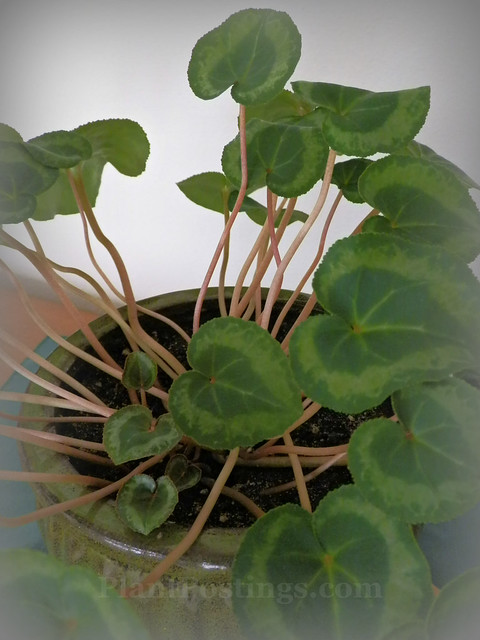
• Before the first frost, I bring my plants indoors for the winter. For me, this happens sometime between early and mid-October. By this point, the Cyclamen is starting to look like a lovely potted foliage plant, perfect as a holiday accent piece.
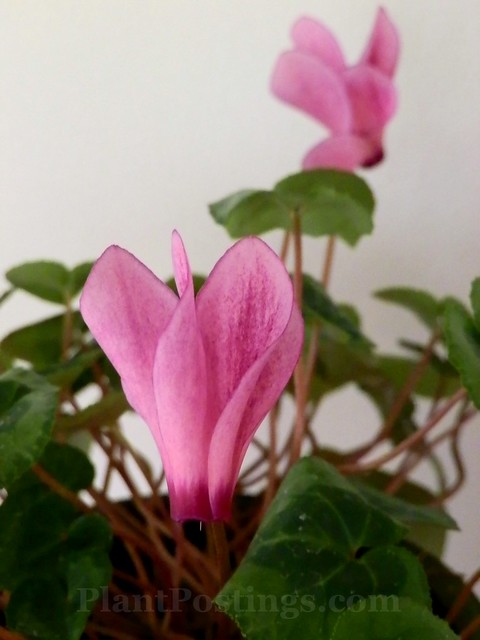
And so the cycle continues. If you've ever tried to grow florist's Cyclamen and have given up, I encourage you to try again. It's easier than you might think, and the hardest part is having faith it will resurrect from its summer dormancy. When it does, it's hard to describe the thrill of seeing new life at a time when most other plants are going dormant.
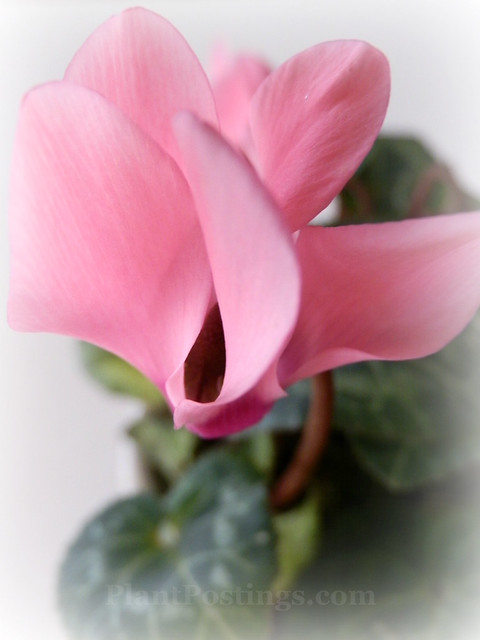
So pretty . . .
ReplyDeleteIt makes me want to try growing one.
As I read your piece I remembered back to days when I had many, many indoor plants. The many successes I celebrated I think were because of the house we lived in. A very large, three story, extremely well built 100 year old + home. Many windows and places for plants. I remember many violets that were given to me by my late husband's mother. Every color and they bloomed profusely. My most exciting success was when my very large Dieffenbachia bloomed this exotic white flower. We moved across the Midwest into Michigan and that plant didn't survive. Bromliad is another plant one has to be patient with during its somewhat dormant times. I enjoyed your post Beth and feel encouraged to try some more indoor plants. I love Cyclamen, I think I will try one.
Thank you, Lynne. I'm starting to think the sunroom is the secret to my recent success, too. I didn't start trying to keep/grow indoor plants in there until a few years ago. And closing it off keeps it cooler and more humid, and reduces the amount of plant pests that are active. Sounds like you've had quite a bit of success with your indoor plants!
DeleteI can't tell you how many of these little beauties I have killed being kind to it. I think they are the most interesting plants. If I see one someplace I might give it another try. I believe I did what you said when they went dormant and tossed them thinking that it just died instead of the idea that it went dormant. Those little blooms are so welcome this time of year. Good going.
ReplyDeleteYes, they really look dead in midsummer. In a couple of years, all I had was bare soil and I really didn't think it would come back. But about late August I saw new growth and started watering it. It's so easy to give up on this plant, but the rewards of patience are great. :)
DeleteI've killed or given up on a few of these but your post has inspired me to try again as they're so pretty and our nurseries are full of them. Thanks for the pointers - So, no on the hokey pokey but yes on the jig when we're past the threat of frost. Got it.
ReplyDeleteYes! The jig is mandatory (OK, the hokey-pokey is fine, too). I think the dancing is the secret to gardening success! ;-)
DeleteLove, love, love ... mine do well for me too, Beth. They seem to enjoy the vacation outside in the summer. If they make it, grand ... if not, no big thing.
ReplyDeleteYes, I think the time outside is helpful, too. It allows beneficial bugs to eat the bad bugs, and the outdoor air and sunshine perk them up. Glad to hear you've had success with Cyclamens, too.
DeleteWe've had better luck with Cyclamen than any other winter houseplants. And pretty much followed your location and conditions. I have an orchid that is about to bloom for the third year and I think it is because I keep forgetting about it which means I don't kill it with overwatering.
ReplyDeleteI think I might try an Orchid again this year. I had one that only lasted through flowering, but I tried to transplant it with regular potting soil, which, of course, was a mistake. Any plants in the main area of the house have to be caged so my cats won't eat them. ;-)
DeleteYour photos are exquisite, as is the Cyclamen. That pink is stunning. Your instructions are great, especially for someone like me who's never been great with indoor plants. My neighbor used to plant Cyclamen in her front bed and they'd do well--until our summers!
ReplyDeleteThank you, Tina. It's been such a joy to see this plant bloom, recede, and bloom again the next season. The blooms have a cloudy, opaque quality to them that is quite lovely. I imagine the heat in your climate would make them crash. It certainly happens here when summer hits!
DeleteBeautiful photos, Beth--such detail! really enjoying the flower color and leaf patterns.
ReplyDeleteThanks, Hollis. It is a great houseplant! The foliage is nice for about eight months, and the flowers last through late winter and early spring.
DeleteYou're doing great with that cyclamen. Kudos! :)
ReplyDeleteThanks, Aaron. LOL. I certainly don't follow the rules, but it seems to like the consistent sun and cool temps in the winter and neglect during the summer.
DeleteThank you for the tips. I do not have a cyclamen. I do have an African Violet that my mom gave me. She too, has all kinds of violets. I killed my original. She gave me a replacement 5 years ago. All is well. :-) I leave it in the same spot, never move it. I water it once a week. That is it! It is happily blooming today.
ReplyDeleteThis winter I am trying to winter over three geraniums. Oh my, one looks awful. I will not give up yet.
Oh, good luck with the Geraniums! They're the ones that have to be hung upside down, right? Or am I thinking of something else? Congrats with the African Violet. I'm not sure I'm brave enough to try one of those again! But they're stunningly beautiful.
DeleteExcellent advice about maintaining a beautiful plant. I love these cyclamen but don't have one this year. In our new house I am having trouble finding a space for houseplants. Alas. I have to work on that.
ReplyDeleteI think it might be luck, but thank you. Or, at least luck in accidentally doing the right thing. Tee hee. I hope you can find a spot for houseplants. I don't have many because of my cats, but it is fun to see lush foliage and flowers during the winter.
DeleteThis is such a great post. I'm terribly with most indoor plants including cyclamen because I just don't seem to care enough about them. I love that you don't do the hokey pokey either, but have found this plant's sweet spot. Thank you so much for writing this.~~Dee
ReplyDeleteThanks, Dee. Yes, the hokey-pokey isn't required for success in growing Cyclamen plants. ;-) I like having green, growing things around during the winter, but I'm not big on complicated steps to make it work. So, I'm lucky this little plant likes the conditions in the sunroom.
DeleteGood post. I like Cyclamens, but I have never grown them, either indoors or outdoors.
ReplyDeleteThanks, Jason. If you don't care much about the rules and you have patience, they really aren't as difficult as their reputation.
DeleteGorgeous! I have always admired cyclamen. I have very few indoor plants; I may be one of the rare people in the world who managed to kill a cactus by not watering it enough! Talk about neglect! I admire your cyclamen and your ability to give it just what it needs, without doing the hokey pokey!
ReplyDeleteHa! I've been the same way with indoor plants over the years, Deb. In recent years, I think dedicating the sunroom to plants during the winter has given my luck a little boost. Just the right mix of bright sun, a cooler and more humid environment, and a place away from the cats. ;-)
DeleteI get my cyclamens confused but I think C. persicum are a larger species and have the telltale leaf edge beading like yours. A brilliant post Beth on how to cosset a cyclamen - looks especially happy on your hall table.
ReplyDeleteI have a few hardy cyclamens blooming outside (C.Coum)but also my 2 C. Persicums are relegated there toofor Spring blooming. The weather more temeperate here and squirrel diggers are the biggerst threat. I note Paghat's garden grows hers outside too
Thanks! How nice to be able to plant them outside in your milder climate. Many people around here plant hardy Cyclamens in the soil, but we are much too cold for C. persicum. Squirrels are a bit of a challenge here, too, along with chipmunks and rabbits--the latter are my biggest problem!
DeleteA pretty flower!
ReplyDeleteYes, it's a joy to see at this cold, gray time of year!
DeleteYour cyclamen looks very happy! You have the perfect conditions for it.
ReplyDeleteThank you. It does seem very happy in the sunroom. I pretty much neglect it during the summer, which apparently is the appropriate inaction. ;-)
DeleteYour cyclamen look fantastic, great work! I love them and now have in my balcony 4 of them. Unlike in your climate in most Spain cyclamens are fall and winter plants, they might go through spring time and if in the North also summer, but they suffer a lot in dry hot summers. I had time ago plants that lasted several years, but now I with climate change I will need to find a way to maintain the new ones alive during really hot summer. Fingers crossed!
ReplyDeleteWell, I really don't try very hard, but apparently the combo of indirect all-day light during the cold months and neglect during the warm months is what it wants. Tee hee. Yes, our summers can be pretty hot here, too, believe it or not. The plant goes dormant during June, July, and August.
DeleteI love cyclamen, but somehow I never got one this year. I don't seem capable and carrying them on very often Yours look really beautiful. I'll bet I still have time to find one . I'm going to look.
ReplyDeleteOh, yes, I'm sure they're available at florists and garden centers currently. It seems they're easy to find (around here anyway) through Easter. If you get one and it dies back in summer, just put it in a corner outside and water it once a month. It will probably come back in September. :)
Delete